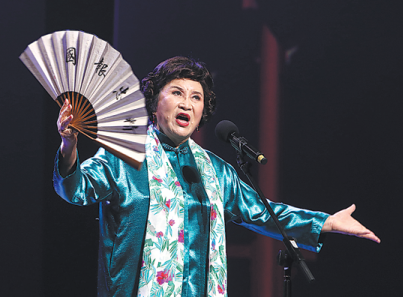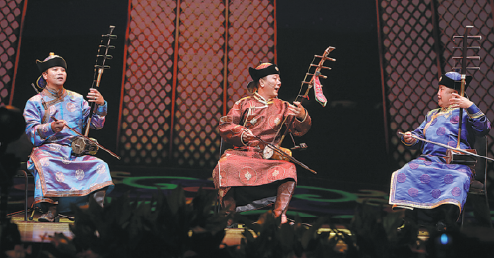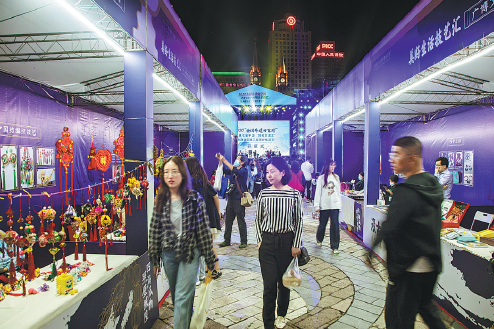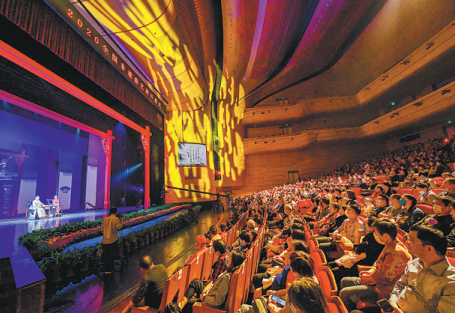 Liu Lanfang, a veteran artist of pingshu, performs at the recent 2020 National Intangible Cultural Heritage Quyi Week in Ningbo, Zhejiang province. CHINA DAILY Liu Lanfang, a veteran artist of pingshu, performs at the recent 2020 National Intangible Cultural Heritage Quyi Week in Ningbo, Zhejiang province. CHINA DAILY
China's traditional storytelling genres are so diverse that the umbrella term quyi-literally, the meaning of art and songs-was created to encompass them.
Today, 127 of China's 1,372 national-level intangible cultural heritage projects are categorized as quyi.
These were spotlighted at the 2020 National Intangible Cultural Heritage Quyi Week in Ningbo, Zhejiang province, from Oct 9 to 14.
The event's third edition featured online and offline performances, forums and seminars.
The festival aims to integrate the traditional art forms into everyday modern life.
One approach is by organizing art-troupe performances in such venues as communities, schools and scenic spots.
Ningbo is home to three national-level quyi genres, including the 300-year-old Siming nanci. Siming is a famous mountain in Ningbo that's often used in references to the city. Nanci is a form of ballad that's also found in other parts of the country.  Performers of the Mongolian ethnic group stage a show at the opening ceremony. CHINA DAILY Performers of the Mongolian ethnic group stage a show at the opening ceremony. CHINA DAILY
National-level intangible heritage inheritor Chen Xiangyuan and his student Qian Houyin performed at the event. They have performed onstage for decades.
Qian, who previously specialized in traditional Chinese operas, explains that Siming nanci is a branch of quyi that leans toward highbrow tastes. Its lyrics in particular require exquisite composition and refined word choices, like poetry.
"I got the chance to perform it several years ago," he says.
"Its instrumentation, singing and performance styles seemed very beautiful and elegant. So, I decided to study it systematically."
But the genre has faced a decline in recent years, as its masters age and few apprentices take it up.
"There are very few male performers, and those who are learning it now are older. So, although I'm 45 years old, I'm still among the younger generation of male performers," he says.
"I'd like to call for public attention to this genre. The art form is on the verge of dying out in terms of the number of teachers, students, performers and subject matters. Many masters are over 70. We need more opportunities to cultivate young students and introduce nanci to a broader audience."
The Ministry of Culture and Tourism's intangible cultural heritage department and art department; the Zhejiang Provincial Department of Culture and Tourism; and Ningbo's government hosted this year's Quyi week.
The festival gave abundant platforms for genres around China.  Lianhualao artist Weng Renkang performs Three Slaps. CHINA DAILY Lianhualao artist Weng Renkang performs Three Slaps. CHINA DAILY
Nearly 260 performances were presented online, while others were staged live. Experts and artists also joined forums and seminars.
The quyi genre lianhualao, from Zhejiang's Shaoxing, marked the opening ceremony.
Lianhualao has a wider audience base thanks to its clarity and witticisms.
Representative lianhualao performer Weng Renkang brought a routine entitled Three Slaps.
It presents a humorous take on a street-side argument in which Weng advocates civility over aggression.
"Lianhualao employs a lively performance style. We use our local dialect to portray the stories, so the stories strike the right note with audiences," Weng says.
"It also highlights wisecracks through language and storylines."
He thoughtfully selected this story set in a modern scenario rather than a classical routine.
"To promote folk arts, we need to compose works that appeal to the general public, especially youth," he says.
"We're also experimenting with novel performance styles through song and the spoken word. When we perform in other parts of China, we use Mandarin with a Shaoxing accent rather than the Shaoxing dialect so audiences can understand."  Quyi week in Ningbo also features outdoor performances and markets. CHINA DAILY Quyi week in Ningbo also features outdoor performances and markets. CHINA DAILY
Weng started learning lianhualao as a child from Hu Zhaohai, who's now a national-level inheritor of the genre.
"Over 100 years ago, lianhualao performances had no instruments at all-just one storyteller and one person with bamboo clappers. In the 1950s and '60s, the performances incorporated sihu (a four-stringed bowed instrument)," Hu says.
"After the '70s, we added more instruments and started to perform as a quartet to better entertain audiences. Generally, lianhualao has continued to reform and innovate."
Hu established the Shaoxing Folk Quyi School in 1998 and cultivated over 20 students, many of whom have become leading artists in Shaoxing and have won such national awards as the China Quyi Peony Award.
Thanks to the efforts of Weng and Hu, lianhualao today has more young students.
Weng's daughter, for example, began learning and performing it after graduating from the Zhejiang Conservatory of Music. The woman, who's in her 20s, also appeared onstage during the opening ceremony.  The Ningbo Culture Plaza Grand Theater sees a full house at the opening performance on Oct 10. CHINA DAILY The Ningbo Culture Plaza Grand Theater sees a full house at the opening performance on Oct 10. CHINA DAILY
The transformation and development of lianhualao is acknowledged by Liu Lanfang, a veteran performer of pingshu, another traditional Chinese form of storytelling.
This year marked the third time Liu has attended the National Quyi Week. She says she feels encouraged and empowered each time.
"Performances are the only way to examine the amount of work quyi artists have done in the past year," she says.
"We can see how many talents artists have cultivated every year, and more people can learn about these quyi genres. More importantly, students can become motivated to continue learning.
"These performances can also attract more audiences. Inheriting intangible culture is a strategy. And developing and promoting the arts is the ultimate goal."
Contact the writer at chengyuezhu@chinadaily.com.cn |